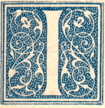[The following attack on public portrait sculpture comes from “If I Were Ædile” Beerbohm's More. George P. Landow scanned and formatted the text, adding links to material on this site. The decorated initial appears in another essay in the original book. Ædiles were the officials in ancient Rome responsible for its public buildings.]
 should make very short work of
any Victorian statues I saw standing about.
There are many of them. There is no escape
from them. For sculpture is the most obtrusive of all arts. Its elemental grandeur,
its breadth of aspect, swiftly impressive, and
the archaic hardiness of its material, give it
a right in aëre, in frigore, in imbri [in air, cold, and rain]. It was
the supreme decoration of great cities. It is
the supreme disfigurement of great cities,
None but a sculptor and his mother would
deny that it is a lost art. And yet, whenever
an eminent person dies, we know (nor seem
to care) that, within a year or two, his friends
will have foisted on some street or square a
marble abortion so obscene that no one in any
future generation can, by any possibility, forget him. I am the last person to disparage
grotesques; but I do not think they are quite
a nice means of commemorating our mighty
dead. If England, in her old age, is beginning to lose her memory and cannot, without
some system of mnemonics, remember the
names of her great sons, she had better make
up her mind to forget them at once. At any
rate, she really must dispense with such
ghastly reminders as the work of her modern
sculptors. [98]
should make very short work of
any Victorian statues I saw standing about.
There are many of them. There is no escape
from them. For sculpture is the most obtrusive of all arts. Its elemental grandeur,
its breadth of aspect, swiftly impressive, and
the archaic hardiness of its material, give it
a right in aëre, in frigore, in imbri [in air, cold, and rain]. It was
the supreme decoration of great cities. It is
the supreme disfigurement of great cities,
None but a sculptor and his mother would
deny that it is a lost art. And yet, whenever
an eminent person dies, we know (nor seem
to care) that, within a year or two, his friends
will have foisted on some street or square a
marble abortion so obscene that no one in any
future generation can, by any possibility, forget him. I am the last person to disparage
grotesques; but I do not think they are quite
a nice means of commemorating our mighty
dead. If England, in her old age, is beginning to lose her memory and cannot, without
some system of mnemonics, remember the
names of her great sons, she had better make
up her mind to forget them at once. At any
rate, she really must dispense with such
ghastly reminders as the work of her modern
sculptors. [98]
Bibliography
Beerbohm, Max. “If I Were Ædile.” More (1899). New York: Dodd, Mead, and Company, 1922. 89-100.
Last modified 6 December 2011